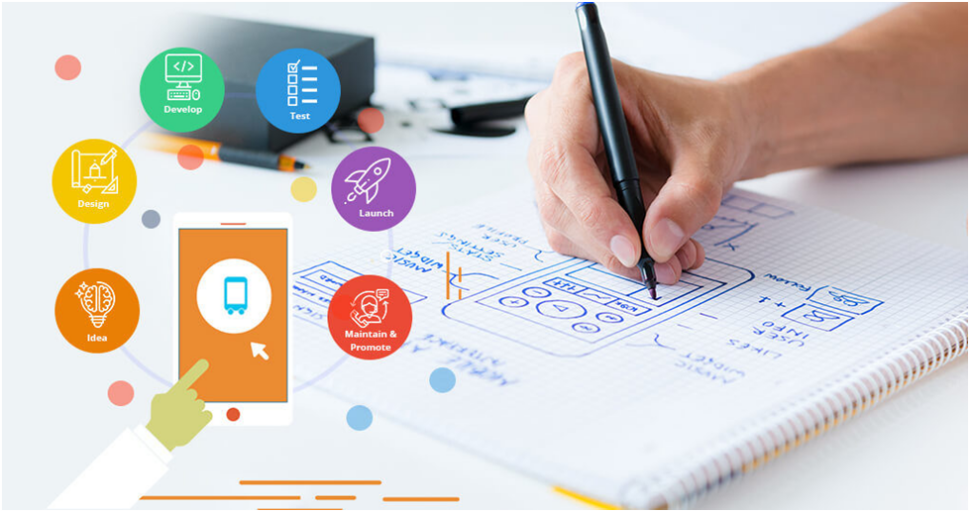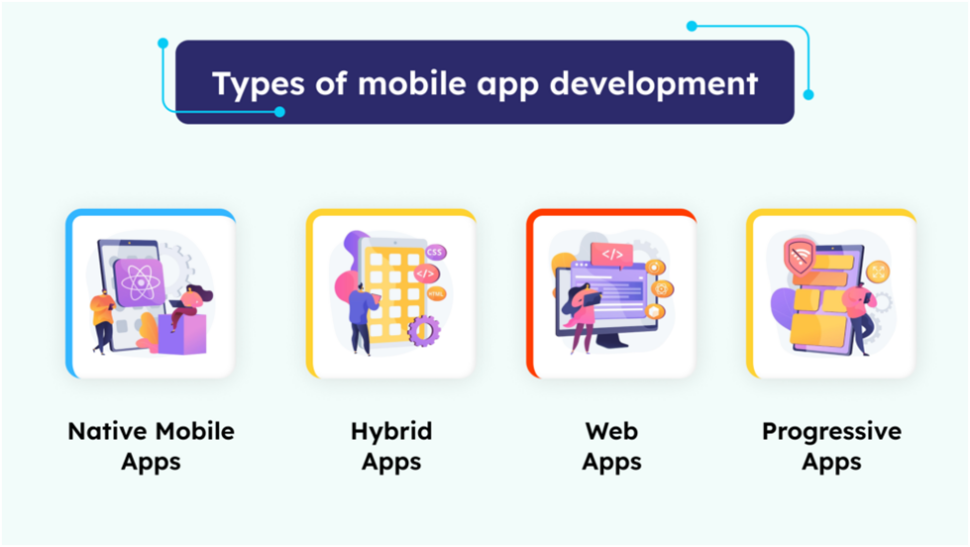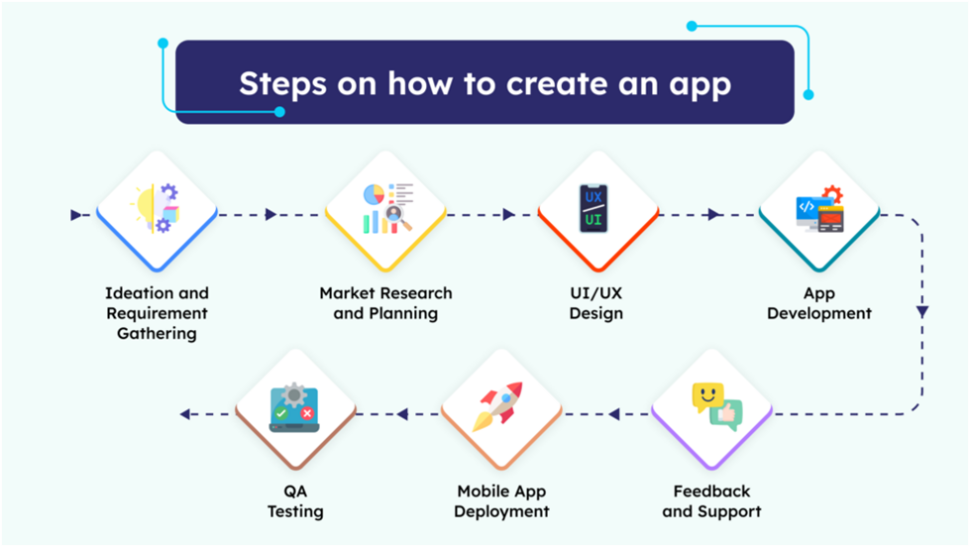Creating a mobile app starts with an idea and goes through several steps. First, we gather what the app needs and do some research. Then, we plan out how it will look and work. Next, we design how users will interact with it. After that, we build the app. We test it a lot to make sure it works well. Finally, we release it on places like Android and iOS.
Once the app is out, we keep working on it to make sure it stays good and fix any problems. To make these apps, we use tools like Buildfire.js, Ionic, and Xamarin. We also use software development kits like Flutter and React Native. The languages we use are Swift, Java, Kotlin, and others.
Lots of people are using mobile apps, and they spend a lot of money on them. The market for these apps is growing fast because there are always new and better smartphones and tablets coming out.
Apps can make a lot of money from app stores and ads, and that’s why businesses want to make their apps.
No matter what business you’re in, having a mobile app is crucial to doing well in today’s competitive market. Apps make things easier for users and can give your business an advantage if you plan well and follow a good app development process.
Making a mobile app means creating a program that works on phones or tablets, designed for a particular group of people. These apps can be for socializing, health, games, education, and more.
Now, let’s talk about the steps in making an app. But before that, let’s understand why it’s still important to invest in mobile app development.

Why Invest in Mobile App Development?
Think of your business like a shop. People can walk in and buy your products, but they have to travel a long way to get there. It’s like your shop is in the middle of nowhere!
Now, picture having a mobile app. People can look at and buy your stuff anytime, anywhere, right from their phones. It’s like having a tiny shop in everyone’s pocket!
That’s what mobile apps do for businesses. They make it easy for people to find and buy your stuff, bringing in more sales and growth.
Here are some more reasons why you should put money into making a mobile app:
- Reach a wider audience: There are billions of smartphones in the world, and people spend a lot of time on them. With an app, you can reach a much larger audience than you could with a traditional brick-and-mortar shop.
- Increased customer engagement: Apps can provide a more interactive and personalized experience for your customers. You can send them push notifications, offer them exclusive deals, and get feedback directly from them.
- Build brand loyalty: A well-designed app can help you build stronger relationships with your customers and make them more loyal to your brand.
- Stay ahead of the competition: More and more businesses are developing mobile apps. If you don’t have one, you could be falling behind your competitors.
- Increased Revenue and Conversion – Online businesses are booming. If you focus on mobile marketing, you could get 80% of your sales, with almost 40% coming from apps. So, creating a mobile app is crucial for your business to grow.
Of course, making a mobile app might cost you, but when done well, it can be a fantastic way to expand your business.
Now that you understand the reasons to invest in app development, let’s explore the different kinds of mobile app development.
Also Read: How to Hire Developers for Startup: Quick Tips
Types of Mobile App Development
When businesses begin making a mobile app, they often think a lot about how it will look. But what’s even more important is deciding what kind of app they want.
There are many options, and picking the right type and technology is really important to make your app idea real. There are four main types of Mobile App Development.

To assist you in making a decision, let’s talk about each of them below.
Native Apps:
- Made for either iPhone (iOS) or Android, using platform-specific programming languages (Swift/Objective-C for iOS, Java/Kotlin for Android).
- Gives the best performance, user experience, and access to device features.
- Needs to be built separately for each platform, making it more expensive and complex.
Hybrid Apps:
- Combine web technologies (HTML, CSS, JavaScript) with a native container app.
- Works on different platforms with just one set of code, saving time and money.
- Might not be as fast or use all the cool features of the device like native apps do.
Web Apps:
- Use a web browser on any device with the internet to get to them.
- No need to install anything; they are always ready to use.
- May have limitations in functionality and user experience compared to native or hybrid apps.
Progressive Web Apps (PWAs):
- A web app that feels like a real app, made with modern web stuff.
- Offer features like offline access, push notifications, and home screen installation.
- Can be a good option for businesses looking for a cost-effective solution with broad reach.
*Note: Picking the right way to make your app depends on various factors like your target audience, budget, desired features, and technical expertise. Consider consulting with experienced developers to figure out the best way for what you want.
Now that you’re familiar with the kinds of mobile apps, once you pick one, we can go to the next part: the steps for creating a mobile app. The stages of mobile app development are pretty much the same for all types.
How Mobile Apps are Created – Stages and Steps in Mobile App Development Process
Now that you’ve chosen to make an app for your idea or business, it’s crucial to understand how apps are created and the steps involved.
Below, you’ll find details about the steps and stages in the process of making a mobile app, forming the lifecycle of your application.

The diagram above shows the steps for making an app.
To know how an app is created, it’s best to look carefully at the step-by-step process, explained below.
Stage 1: Ideation and Planning
When you start a project, first, think about your idea. Then, find out what you need for the project to make sure it’s worth spending time, money, and effort on. Every project should begin with detailed client interactions to understand what they expect from the mobile application.
- The objective of the App: Why Make the App? Understand why you want the app. Does your idea match what your company or audience needs?
- Target Audience: Know who your target audience is and potential users.
- USP of the app: Important features and core appeal of the app. What makes it special? Why would people choose your app over others?
- Competitor Analysis: Who are your competitors, and do they have a similar app? Any issues that customers face? If yes, Will your app solve the problems they have?
- App Investment and Promotion: Mobile app development requires time, money, and effort. Are you willing to spend so much, or do you have a defined budget for the same? What will be your promotional strategies to avail new customers?
If you are ready for the questions above, you can move on to the next step in the app development stages.
Stage 2: Market Research and Planning
Planning is really important as your app idea becomes a real project. Researching the market helps you figure out if people want your product. Here’s how you do it:
- Set Goals and Know Your Customer: Figure out what you want and who your customers are.
- Ask Questions: Make a list of questions and find the answers, talk to people who might use your app, and check out what your competition is doing.
- Keep it Informative: Make sure your survey has good info and also check what others are doing.
Market research helps you understand customers, see what others are doing, check products before releasing, find business chances, and know what users want.
Once you know what you need, make a plan, choose a name and domain for the app, decide what’s most important, and split the work into smaller parts.
Lastly, figure out the skills you need, what kind of app you want, and how big it will be.
Stage 3: UI/UX Design
Your app’s success relies on how much users like and use its features. The aim of mobile UI/UX design is to make an app that’s easy to use, interactive and provides a great user experience.
Starting with User Interface (UI) Design, you decide what info goes on your app, how users will use it, and their journey in the app. Workflow diagrams help plan how users will move around and use the app. There are also other things to consider in this process.
- Wireframes: These are like blueprints that show you how the app should work. They are a quick and budget-friendly way to plan out your mobile app design.
- Style Guides: They write down the rules for how your app should look, like the colors, fonts, and pictures, based on your company’s branding rules. Using a style guide makes sure your app looks and feels the same everywhere.
- Mock-ups: These are the last versions of how your app will look, known as high-fidelity designs. Tools like Figma, Invision, and Adobe XD help create them, making it easy for the design and engineering teams to work together.
- Prototype: They simulate user experience and how they would work with your app as a finished product. Prototype development can be time-consuming, but they are well worth it as it tests your app’s design and functionality.
Also read: Difference Between Wireframe, App Prototype & Mockup
Stage 4: App Development
This is a really important part of making an app. In this phase, you decide how the app will work, write the code, and set goals for the different steps.
First, you need to decide which way to make your app—either Native, Cross-platform, or web apps.
Now, let’s look at the three main steps in making a mobile app.
- Frontend Development: This is the part where you, as the user, use the app on your phone. Whether the app is good or not depends on how well it works when you use it. It’s important to use technologies in making the app that make the screens work well, communication smooth, and the whole thing easy to use.
- Backend Development: The part of the app that works behind the scenes is crucial. It makes sure everything runs smoothly and responds well to your actions. The backend development is important for deciding what the app can do and making it work better.
- Integration and Database Management: Data movement from the frontend to the backend and vice versa is essential. The choice of API integration and database management can determine the speed of the app owing to integration with the app and the type of device.
On average, an app development timeline can take between 2 to 12 months, depending on the complexity of the app and the structure of your project, excluding other stages.
Flutter Pros and Cons: Everything About Framework
Technology Stack
| App Development Type | Tech Stack/Mobile app development frameworks |
| Native Android App Development | IDE: Android Studio, IntelliJ IDEA Programming Language: Java, Kotlin |
| Native iOS App Development | IDE: XCode Programming Language: Objective-C, Swift |
| Cross-platform | Flutter, React Native, PhoneGap Backend: Node.js, .Net, PHP |
Step 5: QA Testing
Once the app is built, it’s important to carefully check the code for any big problems. Also, do a final test to make sure the app looks good and works well. This is the last chance to find and fix any mistakes.
Now, let’s talk about the different stages of testing the app after and during the development process.
- Documentation Testing: The first testing stage is where strategy begins with layouts, navigational charts, and other essential aspects. Check for the wanted features and make them high-performing before app development begins.
- Functional Testing: It helps you test your mobile app’s industry requirements. Keep in mind the following components –
- Business functionality: Usable for net banking, social networks, education, e-commerce, ticketing, etc.
- Target audience: Age, location, app usage, etc.
- Distribution challenge: Google Play, App Store, direct hosting on the software or legacy system
- Usability Testing: This testing of the app is done to check user convenience, efficiency, and effectiveness when using the app.
- UI (User Interface) testing: This testing ensures that the app’s GUI meets all the specifications.
- Compatibility testing: This testing ensures the optimal performance of the mobile app as per the device size, hardware, version, screen resolution, etc., and its respective configurations are checked too.
- Performance testing: This tests your mobile app’s consistency under a specific workload. It consists of various types:
- Stability Testing
- Load Testing
- Stress Testing
- Concurrency Testing
- Volume Testing
- Security testing: It helps validate the security and risk aspects of your application from hackers, viruses, protection, and unauthorized access to sensitive data.
- Certification testing: This is carried out to check if your app meets industry standards, terms of use, licensing agreements, and all the requirements of respective app stores.
Some top mobile app development tools for testing include Xamarin UITest, Appium, Kobiton, Robotium, Test IO, Play Console, etc.
Stage 6: Mobile App Deployment
First, you can release a beta version of the MVP (Minimum Viable Product) to get early users and make your app more popular. Users will give feedback, helping you improve the app. After testing and making it better, you can fully launch it.
When everything’s ready, put it on Google Play Store or Apple Store. Make sure your app is optimized for the specific app store before it goes live. Before launching, check if your app has the following:
- Name and description of the app
- List of features with explanations
- App Category
- Relevant keywords and phrases
- Icon in the right sizes
- Clear screenshots of the app
Follow proper app store quality guidelines before you launch the mobile app and optimize it accordingly.
Step 7: Feedback, Support & Maintenance
This is the last part, where people start using the app and sharing their thoughts. For the first few months, the company that made the app should provide support.
During this time, businesses need to listen to feedback, make changes often, and keep improving the app over time to make it successful.
Now that you understand how apps are made, let’s look at some common mistakes to avoid when creating an app for your business.
Mistakes to Avoid when Developing A Mobile App for Your Business
So, how do you make sure your app is unique and gives your business an advantage? Here are some things to avoid when creating a mobile app.
- Lack of Understanding Your Audience:
Think about what your users want and how you can make things better for them. It’s a mistake to ignore these questions. Knowing your audience is crucial; successful apps come from really understanding what users need.
Do deep research on the market to know what people want, like, and find challenging. Build your app to solve their problems and fit into how they use apps. - Setting Unrealistic Budgets:
One common mistake by business owners is not planning the budget well for creating a custom app. To avoid problems, plan for unexpected costs, do thorough research and create a detailed budget before starting the app development.
Understand your target audience, decide on app features, design elements, and how you plan to make money with the app. Even with a detailed budget, leave room for unexpected costs and issues that might come up during the app development process. - Too Many Features:
It might seem like a good idea to put lots of cool stuff in your app, but be careful! Too much can confuse users and make the app slow. Focus on the most important things that match what your app is about, and make sure they work perfectly. In the app world, having things that work well is more important than having lots of things. - Bad Design:
If your app is hard to use and looks messy, it’s not good for users. Spend time on design that focuses on what users find easy and nice. The first time users see your app is important, and it’s often the design that gives them their first impression of your brand. - Fixing Problems with Bugs:
Launching an app full of problems is like throwing a party with bad lights and old food. It’s important to test the app a lot during development. Get quality assurance experts to find and fix problems before the app goes public and becomes embarrassing. - Neglecting Maintenance:
Your app is a living, breathing system, not just a one-time project. Keep making it better with new features, fixing problems, and making it work faster. Listen to what users say and fix things quickly. A well-kept app makes users happy and they keep using it.
To make a great app and boost your business, avoid these common mistakes. Developing an app is a long process, not a quick one. With good planning, smart actions, and always trying to make it better, your app can stand out in the tech world.
Wrapping Up
Creating a mobile app can feel like a lot, but it’s worth it. This guide gives you a good look at the whole process.
If you want to talk about your project, we’re here for you. Ailoitte is a trusted company for making mobile apps and helping businesses transform digitally. Our expert team can create great apps for Android, the web, and iPhone all around the world.
We’re ready to answer some common questions to help you make the right choices.
FAQs
To make an Android app:
1. Understand your brand and check out the competition.
2. Pick a name and decide on features.
3. Create design plans and choose the right technology.
4. Follow the development process and best practices.
5. Test your app well before putting it on the Google Play Store.
6. Keep making your app better with updates.
To create an iOS app:
1. Decide on your app idea and check out the competition.
2. Choose the features and plan the app’s design.
3. Build the app using React Native, Xamarin, Swift, or Objective-C.
4. Submit your app to the App Store.
5. Keep making your app better based on user feedback.
Making a simple app usually takes about a month. A medium-sized app might need 6-7 weeks, and a bigger app can take 9-10 weeks. On average, it can take 1-3 months to launch a basic version (MVP) and 6-12 months to make it a really good product.
There are three main types of mobile apps. Native Apps are built specifically for each platform: iOS and Android. Web-based apps that can be accessed through a web browser and Cross-platform App development built for Android and iOS devices.
The app development process starts with the idea that can solve real-life problems. It is like the aim of your app and what features would make it stand out for the users.
The 4 phases of mobile app workflow are ideation and market research, design and development, testing, and providing maintenance/support.



















.png)
.png)
.png)



Thank you for your sharing. I am worried that I lack creative ideas. It is your article that makes me full of hope. Thank you. But, I have a question, can you help me?
Your article helped me a lot, is there any more related content? Thanks!
Your article helped me a lot, is there any more related content? Thanks!
Mobile app development is like sculpting the future with lines of code. It’s incredible how developers transform innovative ideas into functional and user-friendly apps that enhance our daily lives. Your blog must be a treasure trove of insights, guiding developers through the maze of challenges and breakthroughs in this dynamic field. Excited to dive in and explore the latest trends, tools, and techniques that shape the world of mobile app development!”